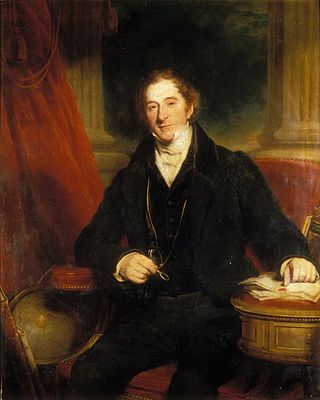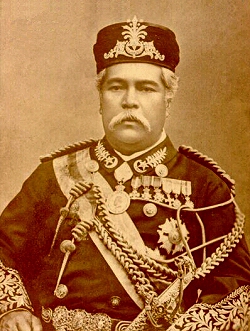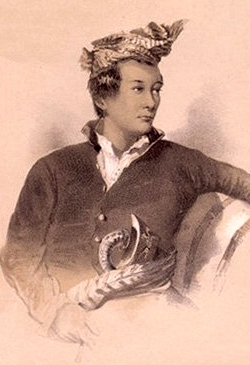
Henry Thomas Colebrooke FRS FRSE FLS was an English orientalist and mathematician. He has been described as "the first great Sanskrit scholar in Europe".

Sir George Thomas Staunton, 2nd Baronet was an English traveller and Orientalist.

Sultan Sir Abu Bakar Al-Khalil Ibrahim Shah ibni Almarhum Temenggong Seri Maharaja Tun Daeng Ibrahim Al-Aydrus was the Temenggong of Johor. He was the 1st Sultan of Modern Johor, the 21st Sultan of Johor and the first Maharaja of Johor from the House of Temenggong. He was also informally known as "The Father of Modern Johor", as many historians accredited Johor's development in the 19th century to Abu Bakar's leadership. He initiated policies and provided aids to ethnic Chinese entrepreneurs to stimulate the development of the state's agricultural economy which was founded by Chinese migrants from Southern China in the 1840s. He also took charge of the development of Johor's infrastructure, administrative system, military and civil service, all of which were modelled closely along Western lines.

The Singapore Stone is a fragment of a large sandstone slab which originally stood at the mouth of the Singapore River. The large slab, which is believed to date back to at least the 13th century and possibly as early as the 10th or 11th century, bore an undeciphered inscription. Recent theories suggest that the inscription is either in Old Javanese or in Sanskrit, which suggested a possibility that the island was an extension of the Majapahit civilization in the past.

Beshbalik is an ancient Turkic archaeological site, now located in Jimsar County, Changji Hui Autonomous Prefecture, Xinjiang, China. The ancient city was initially called Beiting or Ting Prefecture, and was the headquarters of the Beiting Protectorate during the 8th century. It was later known as Beshbalik and became one of the capitals of the Uyghur Khaganate and then the Kingdom of Qocho.

Sultan Sultan Ali Iskandar Shah I ibni almarhum Sultan Ahmad Hussein Muazzam Shah I was the 20th Sultan of Johor, who succeeded his father, Sultan Hussein after the latter died of natural cause in 1835. Over the next twenty years, Sultan Ali's claims to the office of Sultan of Johor were only recognised by some merchants and a few Malays. Like his father, Sultan Ali's was much of a puppet monarch and played a minimal role in the administrative affairs of the state, which came under the charge of the Temenggong and the British. In 1855, Sultan Ali ceded the sovereignty rights of Johor to Temenggong Daeng Ibrahim, in exchange for a formal recognition as the "Sultan of Johor" by the British and a monthly allowance. Following the secession of Johor, Sultan Ali was granted administrative charge over Muar until his death in 1877, and in most administrative matters, was often styled as the "Sultan of Muar".

Kapitan China Chung Keng Quee was the founder and administrator of modern Taiping in Perak, Malaysia. Appointed "Capitan China" by the British in 1877, he was a millionaire philanthropist and known as an innovator in the mining of tin. He was involved in many other industries including farming, pawnbroking and logging. He was respected by both Chinese and European communities in the early colonial settlement. His survival in the chaotic era owes much to his standing as leader of the Hai San, a Chinese secret society in British Malaya during the time of the Larut Wars (1862–73). a position he is said to have held till early 1884 although in all probability he continued to remain a leading member. The old fort at Teluk Batu was built by him to safeguard the mine that he opened there. He was a member of the Commission for the Pacification of Larut and sat as one of six members of the Advisory Perak State Council appointed by the British. Commenting on the role of the Perak Council, Richard James Wilkinson wrote,
"It is for the reader, in the light of subsequent events, to judge how far the Councillors were right or wrong, and to see for himself who really did the pioneer work of building up the prosperity of Perak. In the published accounts of British rule in Malaya, sufficient prominence has not always been given to the efforts of these early pioneers; the reaper, intent on his own work, is apt to forget the man who sowed. These Council Minutes are the record of the work of the sowers. A study of that record will show how much the State owes to Sir Hugh Low and to his fellow-Councillors, especially Raja Dris, Sir William Maxwell, and the Chinese towkays, Ah Kwi [Chung Keng Quee] and Ah Yam."

Jimsar County is a county in Changji Hui Autonomous Prefecture, Xinjiang, China. It contains an area of 8,149 km2 (3,146 sq mi). According to the 2002 census, it has a population of 130,000.

Fellows of the Royal Asiatic Society of Great Britain and Ireland are individuals who have been elected by the Council of the Royal Asiatic Society to further "the investigation of subjects connected with and for the encouragement of science literature and the arts in relation to Asia".
Sir Richard Olaf Winstedt, or more commonly R. O. Winstedt, was an English Orientalist and colonial administrator with expertise in British Malaya.
Charles John Irving,, was a British civil servant in the Malay Peninsula.
Tun Habib Abdul Majid bin Tun Ali bin Tun Muhammad was the 19th Bendahara of the Johor Sultanate during the late 17th century. The Johor Sultanate under Sultan Mahmud Shah II saw a gradual decline of royal authority during Tun Habib's tenure as the Bendahara of Johor. Internal challenges within the Sultanate faced by Tun Habib consolidated his power as the Bendahara, in which case the Bendahara monopolised legitimate authority over the Johor Sultanate by the 1690s. After his death, Tun Habib's descendants spanned throughout the Johor Sultanate and established ruling houses in Riau-Lingga, Johor, Pahang and Terengganu.
Richard James Wilkinson was a British colonial administrator, scholar of Malay, and historian. The son of a British consul, Richard James Wilkinson was born in 1867 in Salonika (Thessaloniki) in the Ottoman Empire. He studied at Felsted School and was an undergraduate of Trinity College, Cambridge. He was multilingual and had a command of French, German, Greek, Italian and Spanish, and later, Malay and Hokkien which he qualified in, in 1889, while a cadet after joining the Straits Settlements Civil Service. He was an important contributor to the Journal of the Malayan Branch of the Royal Asiatic Society (JMBRAS). On 7 November 1900 Wilkinson presented a collection of Malay manuscripts and printed books to the University of Cambridge Library. He was appointed CMG in 1912.

Javanese Kshatriya were a Hindu Kshatriya community which originally existed in the island of Java in Indonesia. According to the ancient Hindu law, the Kshatriyas have the exclusive right to bear arms in order to defend the country. Indigenous Kshatriya communities currently exist in India, Nepal, Bangladesh, Pakistan, Sri Lanka, Vietnam as well as in the island of Bali in Indonesia.
Balinese Kshatriya is a Hindu Kshatriya community that exists on the island of Bali in Indonesia. During the second half of the sixth century, Bali had a strong Kshatriya ruling dynasty. The rulers were mostly indigenous Balinese with some Indian blood. These clans mostly belonged to the Nāgavanshi dynasty. However, in due time, these indigenous Kshatriyas became extinct and were replaced by the Javanese Kshatriyas who immigrated to Bali. Most of the Kshatriyas now living in Bali are claimed to be the descendants of King Dewa Agung, who immigrated to Bali from Java. However, there are also a few other Kshatriya clans who were elevated to the Kshatriya status from the Vaishya varna. Altogether, Kshatriyas constitute around 4% of the total Balinese Hindu population.
The Journal of the Royal Asiatic Society is an academic journal which publishes articles on the history, archaeology, literature, language, religion and art of South Asia, the Middle East, Central Asia, East Asia and South-East Asia. It has been published by the Royal Asiatic Society of Great Britain and Ireland since 1834.
Warren Delabere Barnes was a British colonial administrator.
Royal Asiatic Society Hong Kong Branch is an organisation to encourage interest in Asia broadly, with an emphasis on Hong Kong. The society was founded in 1847 and folded 1859. It was revived on December 28, 1959. Its parent association is the Royal Asiatic Society of Great Britain and Ireland.

Charles Otto Blagden was an English Orientalist and linguist who specialised in the Malay, Mon and Pyu languages. He is particularly known for his studies of Burmese epigraphic inscriptions in the Mon and Pyu scripts.
The Malaysian Branch of the Royal Asiatic Society (MBRAS) is a learned society based in Kuala Lumpur, Malaysia.











